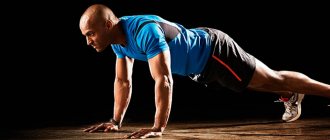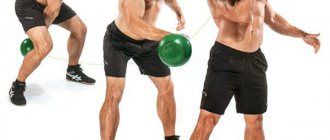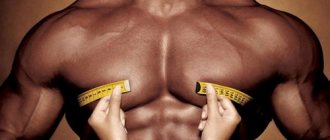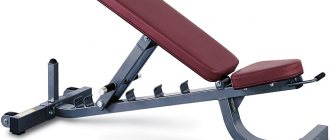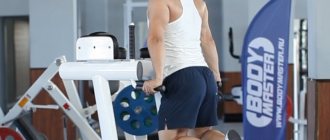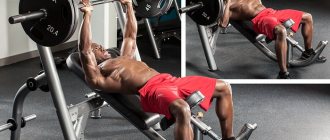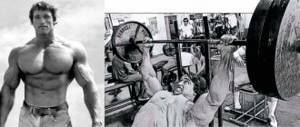An important exercise for giving your body definition is push-ups for the pectoral muscles. With their help, it is possible to influence the bundles of fibers that form beautiful breasts. In fact, this is the reverse analogue of the bench press. Let's take a closer look at the variations of this type of training.
It is very important for men and women to keep their pectoral muscles toned.
Types of push-ups for the pectoral muscles
There are several ways to do push-ups, each of which uses one or another muscle group to a greater extent:
- Firstly, these are classic push-ups. Lying down, hands shoulder-width apart. Lower yourself to the floor, bending your elbows. In this case, the elbows should not stick out too much to the sides, but they should not be pressed closely to the torso either. The back is straight, the pelvis should not sag or stick up. In this position, the load is distributed between the pectoral muscles, arm muscles and trapezius. This method is better suited for complex pumping of the muscles of the entire shoulder girdle and arms.
- Push-ups with arms wide apart. Take a lying position, placing your hands much wider than your shoulders. In this position, the number of repetitions will be less than with a standard push-up, but most of the load will be placed on the pectoral muscles, especially on their outer part. This exercise is similar to the bench press. And the bench press, as you know, is one of the main exercises for the chest.
- Many people perform push-ups with their palms placed very close to each other while lying down. That is, the hands are already shoulder width apart. In this case, the inner part of the chest is perfectly pumped, as well as the triceps on the arms. Doing it is also a little more difficult than classic push-ups.
Three basic chest exercises
The main exercises for anyone who wants to work their pectoral muscles are push-ups, dips, and bench press. Let's study each of these exercises and consider variations of their techniques.
- First exercise: push-ups.
Push-ups involve raising and lowering your torso using only your own hands. During the exercise, the body should be in a horizontal position, the face looking down, the palms and feet serving as support points.
There are several techniques for doing push-ups, which work different parts of the chest in slightly different ways:
- Classic push-up with medium arms. When performing this exercise, your palms are parallel to each other, your arms are shoulder-width apart, your feet are almost next to each other. When lowering, the elbows move along the body. When lifting to the end, you do not need to extend your arms at the elbow joint. With this exercise, the pectoral muscles are moderately activated.
- Push-ups with wide arms. Used to better work out the middle pectoral muscles. Place your hands at a distance approximately twice the width of your shoulders. Elbows are spread to the sides when lowering
- Push-ups with narrow arms. With a narrow placement of the arms, the pectoral muscles are used less, since there is more emphasis on the triceps. But it can also be included in a chest training scheme - with this push-up, the shoulder muscles are activated, which need to be worked so that the torso looks proportional.
- Push-ups with hands behind your back (face up). In this case, your hands are placed behind your back on a slight elevation, and your feet remain on the floor or rest on an opposing bench. When performing, the lower third of the chest is well loaded.
- Push-ups with feet on a stand. Feet can be placed on a step, sports bench or box. Otherwise, the technique for performing the exercise is the same as for basic push-ups. In this case, the upper part of the chest is worked out.
- One arm push up. It is performed as follows: take the starting position, transfer the weight to one hand, and lift the other. Place the leg opposite your supporting arm to the side to maintain balance. When you can easily maintain your balance, begin push-ups. This exercise allows you to work the entire chest area.
- Exercise two: bench press.
The bench press must be included in the scheme for working out the pectoral muscles, since this exercise allows you to achieve very good results. There are three main types of bench press that can increase the strength and mass of the upper, lower, and middle thirds of the chest:
- Bench press from a surface parallel to the floor - in this case, the middle groups of the pectoral muscles are worked out.
- Incline Bench Press. In this case, the man’s head and torso are tilted towards the floor. Allows you to strengthen the lower chest. To get the maximum effect from the exercise, try to straighten your arms as much as possible at the top point. The exercise is difficult, so ask your trainer for help (so he can back you up).
- Press from an elevated bench. This exercise broadens and lifts the upper chest muscles.
- Press with a reverse grip on the barbell (palms facing your face). Allows you to place a stronger emphasis on the upper part of the thoracic region, but you need to be careful, since this option is more traumatic for the shoulder joints.
- Exercise three: dips.
Dips allow you to quickly work out the upper muscle mass of the thoracic region. It involves lifting your own body on outstretched arms with raised legs, the body is held vertically or slightly tilted forward relative to the floor. To increase the load, you can do push-ups with weights that are suspended by straps behind the neck or used in the form of a sports weighted vest (it can be replaced with a backpack with sand).
To pump up the thoracic region, you need to perform the exercise on parallel bars, in which the distance between the handrails is greater than the width of the man’s shoulders. With a narrow arm placement, the triceps, rather than the chest, will be worked, so keep an eye on this.
Pectoral push-up program
To achieve maximum results, it is best to alternate each method. For example: one day you do push-ups only with your arms wide apart, another day you do standard push-ups, the third day you do push-ups with your arms narrowly apart. This will allow you to develop all parts of the pectoral muscle evenly. If you focus on one exercise, your progress will soon stop, since in order to increase strength, mass and endurance, the development of all parts of the muscle is necessary.
In order for the exercises to be productive, you should perform at least five approaches per day . You can do more; lying down and doing push-ups will take you a maximum of five minutes. In each approach you need to do the maximum possible number of repetitions .
Pectoral push-ups - technique with photos and videos
Many athletes, both professional and amateur, include chest push-ups in their training program.
Today we will figure out whether it is possible to pump up the pectoral muscles with push-ups, we will tell you what types of push-ups exist and what the difference is between them, and we will also offer you a complex and a table of push-ups from the floor for the pectoral muscles.
Push-ups - benefits and anatomy
Push-ups are a very versatile exercise that has a number of undeniable advantages:
- Does not require special equipment.
- There is no need to visit the gym and spend a lot of time training. It is enough to allocate only 15-20 minutes a day.
- Suitable for absolutely everyone, regardless of age and gender.
- It helps to work out more than one muscle group, which allows you to increase the tone of the whole body.
Push-ups are mainly aimed at working the chest. However, the following muscle groups are also involved during the exercise:
There are several types of push-ups, but we want to highlight the most common ones and indicate how they differ.
Types of push-ups
Pushups
There are differences here depending on the placement of the arms or legs.
Classic push-ups with hands shoulder-width apart
Allows you to work not only the chest muscles, but also the entire shoulder girdle. Classic push-ups can also be used to work the upper and lower pectoral muscles separately.
In push-ups for the upper pectoral muscles, you need to place your legs above the level of your head. At home, you can use, for example, a sofa as a height.
When doing push-ups for the lower pectoral muscles, your legs should be lower than your head. That is, we place our hands on a hill. Thus, we perform bent-over push-ups.
Push-ups with wide arms
Attention!
Here the target muscles are the pectoral muscles. And to be absolutely precise – its external part. Due to the large distance between the arms, the body lowers, thereby allowing the pectoral muscles to stretch as much as possible.
An even greater effect can be achieved if you perform this version of the exercise on some heights that are placed under your feet and hands. Due to this, the body can be lowered even lower.
Narrow push-ups
Here the target muscles are the triceps muscle and the inner chest. Also, do not ignore dips on the uneven bars for the pectoral muscles. But this option is more suitable for experienced athletes. Without preparation it will be quite difficult to complete.
get acquainted with another very effective exercise for pumping up the pectoral muscles in the article “Humvee Press”.
Today we want to dwell on the analysis of the technique of performing classic push-ups with hands positioned shoulder-width apart. But first, you should familiarize yourself with the recommendations for performing the exercise, which will help you better understand the technique and increase overall efficiency.
On the subject: Is it possible to pump up the press when the uterus prolapses?
Recommendations for performing the exercise
- the exercise at a moderate pace. Do not make sudden jerks or resets. This may cause injury.
- There are no restrictions on the number of repetitions. Perform the maximum number of times for yourself.
- It is not necessary to perform 3-4 approaches at a time. You can complete more throughout the day by doing one at a time when you have free time.
- Push-ups can be used as a separate, independent exercise. But if you decide to add it to your training program, do it at the beginning of your workout.
- Avoid push-ups if you have injuries or diseases of the shoulder girdle.
Now is the time to move on to training.
Classic push-ups for the pectoral muscles - technique
The technique for performing push-ups for the pectoral muscles is the same for both men and women.
In the starting position, stand in a plank position. Hands shoulder-width apart, maybe a little wider. If you are a beginner, place your feet on your knees. If this option seems too simple for you, stand with emphasis on your toes. The entire body from the heels to the crown should create one line.
Important!
As you inhale, lower your body as low as possible. Ideally, your chest should almost touch the floor. Stay at the bottom for a few seconds. This will allow you to master the technique faster. As you exhale, return your body to the starting position. At the top point, do not fully straighten your elbows.
Push-ups may seem like a very simple exercise at first glance, but there are a number of mistakes that novice athletes make.
Errors during the exercise
- Lowering or raising the pelvis relative to the body line. The pelvis should remain motionless. If at any point it becomes difficult for you to do the exercise, just take a break.
- Place your palms above shoulder level.
- Wrist strain. Make sure the load is distributed evenly across the entire palm.
- Jerks while doing the exercise. As already mentioned, this is fraught with injury.
Push-up chart for 15 weeks
We also suggest that you use the following table to plan your workouts and stick to your schedule.
In order to finally understand the push-up technique, we suggest you watch the following video.
Push-ups - video
From this video you will learn which option to perform push-ups to choose, with the goal of working out a particular muscle group, and you will also be able to clearly see how to perform push-ups in different variations.
To summarize, it is worth noting that to get the maximum effect from the exercise, it is important not only to perform push-ups for the pectoral muscles correctly, but also to maintain regular training.
Personal motivation also plays a significant role in working on oneself . With the right and comprehensive approach, very soon you will be able to enjoy the results of your hard work.
Have you already tried the effect of push-ups? Which implementation option did you choose for yourself and why? Tell us about your impressions and results in the comments.
Source: https://www.davajpohudeem.com/sport/uprashneniya/grudnye-myshcy/otzhimaniya.html
Eating the Right Diet to Help Gain Muscle Mass
An important aspect of training is proper nutrition. In order to pump up your pectoral muscles with push-ups, you do not need to create a complex nutrition program and take sports supplements, but it is advisable to follow a healthy diet. Try to eat less sweets and starchy foods, add more protein-rich foods to your diet: meat, fish, nuts, eggs, beans, and so on. You should not purchase artificial supplements, as they are intended for professional bodybuilders. Push-ups don't take as much energy as a full-body workout at the gym, so just eating healthy will be enough.
Types of exercises
To know how to do push-ups to pump up your pectoral muscles, you should consider basic exercises that can maximally utilize this area. The training program must include at least one of them, unless other methods of working the chest area are provided.
Top part
First, let's look at push-ups on the top of the pectoral muscles. You should start with a standard exercise - push-ups with wide arms.
Standard flexion-extension of arms with wide stance
Such training redistributes the load and works the chest well. Since it will be difficult for beginners to complete a full workout from the floor, you can do push-ups from your knees for the first weeks until you get stronger.
A system for the upper pecs typically involves a seated barbell press. You can replace it with push-ups with your head down. In this position, the clavicular area, as well as the delta bundles, are better worked out. The legs should be elevated, and the body and head should be at floor level. To increase the load, you can use your feet against the wall.
About
Upper pectoral push-ups
Most bodyweight trainees avoid using upper pectoral push-ups, focusing on the regular version of this exercise or dips, which primarily develop only the middle and lower pecs. This can affect progress and lead to a less than aesthetically pleasing appearance. How to avoid this is further in the text.
Anatomy and function of the upper pectoral muscles
chest muscle anatomy
Before considering push-ups for the upper pectoral muscles, you need to understand their anatomy and the tasks for which they are responsible. Upper pectoral, lower are relative concepts, so anatomically there is only one pectoralis major muscle.
On the subject: How to pump up a fitball at home
It connects the humerus to the body. Its main task is to bring the arm to the body. Depending on the angle of this movement, one or another part of it becomes tense.
Advice!
When performing regular push-ups (including parallel bars), the arm is brought at the angle for which the middle and lower parts of the pectoral muscles are responsible. Push-ups for the upper pectoral muscles involve the angle of bringing the arms towards the body when they are at chin level.
This can be achieved by two types of exercises with your own weight - push-ups to the bench to the chin and push-ups with your feet on the bench. Let's go through them in more detail next.
Push-ups to the bench to the chin
bench push-ups
To perform this you will need a support (preferably a bench) at or just below the knees. Take the starting position as in regular push-ups, placing your hands on the edge of the bench, wider than shoulder-width apart.
Start to lower yourself until your chin is close to the bench, then rise up and repeat from the beginning.
The exercise is useless if you do not try to concentrate on the work of the upper pectoral muscles throughout the entire exercise.
This type of push-up for the upper pectoral muscles is good to use after approaches to the parallel bars in 5-6 approaches for the maximum number of repetitions in each, in order to comprehensively work out the pectoral muscle mass.
Push-ups with legs on a bench
push-ups with legs on a bench
To perform this we will need the same emphasis, ideally a bench at knee level. Take the starting position for push-ups with your feet on the bench and your hands slightly above shoulder level. When doing everything, also concentrate on working the desired muscle group. This exercise can be used as a basic exercise, alternating it with regular push-ups.
Good luck with your training and don’t forget about push-ups for the upper pectoral muscles.
Source: https://mansanswers.ru/telo/otzhimaniya-na-verhnie-grudny-e-myshtsy
